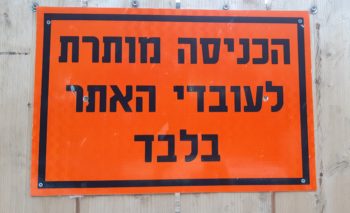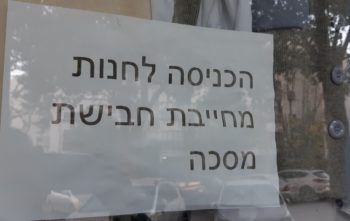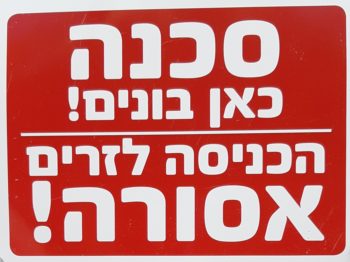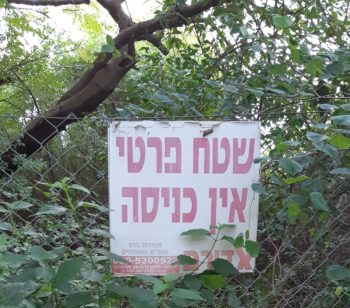Hebrew Words for Entry and Exit Posted by Ayana on Mar 22, 2021 in Grammar, Vocabulary
The Hebrew words for entrance and exit are both feminine. They both end with the feminine suffix – the letter ה:

When talking about a specific entry or exit, we use the singular feminine demonstrative pronoun זוֹ (pronounced as zo), or זוֹהִי (pronounced as zo-i). For example:
לַבִּנְיָן שְׁתֵי כְּנׅיסוֺת, זוֹהִי הַכְּנִיסָה הָרָאשִׁית.
The building has two entrances, this is the main entrance.
זוֹ הַיְּצִיאָה שֶׁמּוֺבׅילָה לַחַנְיוֹן.
This is the exit that leads to the parking lot.
All Semitic verbs are being conjugated. In Hebrew (and other Semitic languages), not only verbs, but almost every word can be changed according to the tense, gender, number, and attribution. An adjective will be different with respect to the gender of the noun it’s describing. Adjectives and verbs referring to כְּנִיסָה or יְצִיאָה will appear in their feminine form. For example:
כְּנִיסָה לָאוּלָם תִּתְאַפְשֵׁר רַק לְאַחַר מְדִידַת חוֺם.
Entrance to the hall will be allowed only after heat measurement.
הַיְּצִיאָה לַגִּנָּה אֲסוּרָה בּׅשְׁעוֹת הָעֶרֶב.
Going out to the garden is forbidden in the evening.
The following sign, for example, was hung on the fence surrounding a construction site. It says: entry is permitted to site workers only.
שַׂר הַחִנּוּךְ אָמַר שֶׁיֵּשׁ לְאַפְשֵׁר לַיְּלָדִים כְּנִיסָה חֲלָקָה לׅשְׁנַת הַלִּמּוּדִים הַחֲדָשָׁה.
The Minister of Education said that children should be allowed a smooth entrance into the new school year.
יְצִיאָה מׅבִּידוּד אֶפְשָׁרִית לְאַחַר 14 יָמִים מׅמוֹעֵד הַחֲשִׂיפָה הָאַחֲרוֹן לְחוֹלֶה מְאֻמָּת.
Exit from isolation is possible after 14 days from the date of last exposure to a confirmed patient.
הַכְּנִיסָה מוּתְנֵית בְּהַצָּגַת תְּעוּדָה מְזַהָה.
Entry is conditional upon presentation of an ID card.
הַכְּנִיסָה חָפְשִׁית אַךְ מוּתְנֵית בְּהַרְשָׁמָה מֵרֹאשׁ.
Admission is free but pre-registration is required.
Another sign on the front of a clothing shop says: entrance to the store requires wearing a mask:
הַיְּצִיאָה מֵהָאָרֶץ עֲלוּלָה לְהִתְעַכֵּב.
Departure from the country may be delayed.
בַּסֶּגֶר הָרִאשׁוֹן אוּשְּׁרָה יְצִיאָה מֵהַבַּיִת לְמֶרְחָק שֶׁל עַד 100 מֶטֶר בִּלְבַד.
In the first lockdown, leaving the house was approved to a distance of up to 100 meters only.
הַיְּצִיאָה מֵהַמַּשְׁבֵּר תְּלוּיָה בְּשִׁתּוּף הַפְּעֻלָּה שֶׁל הָאֶזְרָחִים.
Getting out of the crisis depends on the cooperation of the citizens.
The No Entry traffic sign is called in Hebrew תַּמְרוּר אֵין כְּנִיסָה. The adverb אֵין means no, is not. When this adverb precedes the words entry or exit it indicates no entry or exit is allowed. For example:
אֵין כְּנִיסָה פְּרָט לְדַּיָּרֵי הַבַּיִת.
No entry except tenants.
אֵין כְּנִיסָה לְאוֹפַנַּיִם.
No bicycles allowed.
In Hebrew linguistics, a construct state is a phrase of two nouns that connect to each other. Without using an adjective, construct state is a way to describe a noun and characterize it. For example: a washing machine, the student’ parents, a safety fence, etc. In a construct state the first noun is usually declined. Both Hebrew words for entry and exit are declined the same. Their last syllable changes, the letter ה is replaced with the letter ת. Instead of ending with the vowel /a/ they end with the vowel /at/.

For example:
כְּנִיסַת הָאַמָּנִים נִמְצֶאת מְאֲחוֹרָה.
The artists’ entrance is in the back.
יְצִיאַת חַיָּילִים לַסּוֹף שָׁבוּעַ מַתְחִילָה כְּבָר בְּיוֹם חֲמִישִׁי.
Soldiers’ departure for the weekend begins as early as Thursday.
Common construct states with the nouns entry or exit are:
Emergency exit = יְצִיאַת חֵרוּם
Exodus from Egypt = יְצִיאַת מִצְרַיִם
The commencement of the Sabbath = כְּנִיסַת הַשַּׁבָּת
Keep Calm and Learn Hebrew!

Build vocabulary, practice pronunciation, and more with Transparent Language Online. Available anytime, anywhere, on any device.







